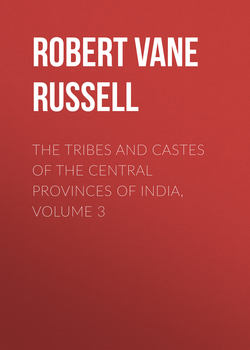Читать книгу The Tribes and Castes of the Central Provinces of India, Volume 3 - Robert Vane Russell - Страница 63
Gond
(f) Religion
45. Bura Deo
ОглавлениеBura Deo, the great god of the Gonds, is sometimes, as seen, a name for all the gods in the Deo-khulla. But he is usually considered as a single god, and often consists of a number of brass or iron balls suspended to a ring and hung on a sāj tree. Again, he may be represented by a few links of a roughly forged iron chain also hung on the tree, and the divine power of the chain is shown by the fact that it can move of itself, and occasionally descends to rest on a stone under the tree or migrates to a neighbouring nullah (stream). Nowadays in Mandla Bura Deo is found as an iron doll made by a neighbouring blacksmith instead of a chain. It would appear, however, that he was originally the sāj tree (Boswellia serrata), an important forest tree growing to a considerable height, which is much revered by the Gonds. They do not cut this tree, nor its branches, except for ceremonial purposes, and their most sacred form of oath is to swear by the name of Bura Deo, holding a branch of the sāj tree above the head. If Bura Deo was first the sāj tree, then we may surmise that when the Gonds discovered iron they held it more sacred than the tree because it was more important, as the material from which their axes and spears were made. And therefore Bura Deo became an iron chain hanging on the sāj tree. The axe is a Gond’s most valuable implement, as with it he cut down the forest to clear a space for his shifting cultivation, and also provided himself with wood for hutting, fuel and other purposes. The axe and spear were also his weapons of war. Hence the discovery of iron was an enormous step forward in civilisation, and this may account for the reverence in which it is held by the Gonds. The metamorphosis of Bura Deo from an iron chain to an iron doll may perhaps be considered to mark the arrival of the Gonds at the stage of religion when anthropomorphic gods are worshipped. Bura Deo is sometimes represented with Mahādeo or Siva and Pārvati, two of the greatest Hindu deities, in attendance on him on each side. Communal sacrifices of pigs and also of goats are made to him at intervals of one or two years; the animals are stretched out on their backs and killed by driving a stake of sāj or tendu72 wood through the belly. Sometimes a goat is dedicated to him a year beforehand, and allowed to wander loose in the village in the name of Bura Deo, and given good food, and even called by the name of the god. It would appear that the original sacrificial animal was the pig, and the goat was afterwards added or substituted. Bura Deo is also worshipped on special occasions, as when a man has got vermin in a wound, or, as the people of the country say, when god has remembered him. In this case the sufferer must pay all the expenses of the ceremony which is necessary for his purification. The dead are also mingled in Bura Deo, as described in the section on funeral rites. Bura Deo is believed to protect the Gonds from wild animals; and if members of a family meet a tiger, snake or other dangerous animal several times within a fairly short period, they think that Bura Deo is displeased with them and have a special sacrifice in his honour. Ordinarily when the Panda or priest sacrifices an animal he severs its head with an axe and holds the head over the image or symbol of the god to allow the blood to drop on it. Before sacrificing a chicken he places some grain before it and says, ‘If I have committed no fault, eat,’ and if the chicken does not eat of itself he usually forces it to pick a grain. Then he says that the sacrifice is acceptable to the god.
72
Diospyros tomentosa.
